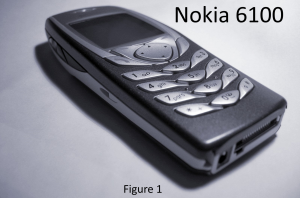In 2002 this was the most popular cellular phone on the market (Kandeel, 2013)

The Nokia 6100 (Meyer, Figure 1.) was acclaimed as one of the first cell phones with a color screen, it had AOL messenger built in and it was one of the first phones to use the GPRS mobile data service which was later described as “the first system providing worldwide mobile Internet access”. GPRS’s maximum connection speed was similar to an analog wire telephone modem connection of about 32–40 kbit/s (Walker, 2013). It must have been very impractical for reading articles. Tonight, I tested my iPhone on M-Lab.net and it clocked in at a “typical” download speed of 9000kbit/s using data. So much has changed since 2002.
Last week as I read through John Willinsky’s article entitled, Democracy and Education: The Missing Link May Be Ours, (2002) on my phone, I continually asked myself why does it seem like so many research papers are still hidden behind special journal memberships or campus logins? Willinsky made a powerful argument for open access and it appeared that efforts made by groups like the Public Knowledge Project and the Budapest Open Access Initiative were showing promise. The emerging power of the internet also showed great promise and Willinsky felt that “given the possibilities for a better informed public, we need to push the democratic experiment by introducing new ways of accessing and utilizing existing sources of information” (p. 372). Nonetheless, in a 2014 interview, Willinsky’s estimated that “about 23 percent of the research produced in a given year is now published in Open Access journals” (Adams, 2014). In his 2002 article Willinsky predicted the obvious obstacles, such as “uncertainties over career impact” (Willinsky, 2002) or publishing companies’ property right concerns but I am curious about the societal changes of this new era of easy access information that might have hindered the progress of OA.
Again in 2014 Willinsky gave an interview with Open Science Platform, where he suggested that one of his most significant obstacles to the progress of OA was an intrinsic “indifference by faculty members and colleagues that are not that interested in anything to do with the question on access” (Open Science Platform, 2014). He went on to say that there was still significant “work to be done with the public in terms of educating them about this new access and the opportunities it presents.” I cannot help but wonder if the indifference among faculty members is a reflection of the indifference among the general public and the media.
What has changed in the “information environment” since Willinsky wrote Democracy and Education in 2002 that made the transition to OA more difficult? A year before, in 2001, the dotcom bubble had burst, and publishers were wary of adopting radical new “free” e-publishing models. (Meyer, 2004) In 2002 the top search engine was Yahoo, but it was being challenged by a promising newcomer named Google with its news aggregator “Google News” and its “mix of memory based and model based algorithms
to generate [news] recommendations” for users (Das 2007). Mark Zuckerberg had just graduated high school and was off to Harvard where he created Facebook. Then in late 2002 the “Fair and Balanced” Fox News surpassed CNN as the number one cable news provider in America. The information environment was changing rapidly and free access to information was no longer a concern for the general public. The concern for the next decade and a half was increasingly what information to absorb and who to believe. Critical thought, inquiry and discovery would increasingly compete with echo chambers, anti-intellectualism, information overload and political polarization. Research published in specialized online journals would have to compete for clicks with 144 character disinformation campaigns on climate change or the safety of vaccinations.
In this post-truth landscape that was emerging, researchers may have felt a greater compulsion to publish their findings in Open Access journals but I question whether the general public felt the need to demand open access? I suspect that more public attention on the issue would have persuaded great participation by faculty and publishers but the transition had been slow.
One of the disturbing aspects of this situation is that it seems to me that democracy requires not only high-quality information, but an attentive audience of citizens willing to engage it.
Adams, Caralee. (2014, Jan) Willinsky honored for developing open access platform. Retrieved from Standford Graduate School of Education News Center website: https://ed.stanford.edu/spotlight/willinsky-honored-developing-platform-promote-open-access-research
Das, A. S. (2007). WWW 2007 : 16th international world wide web conference. New York, New York, USA: ACM.
Kandeel, A., & Sali, D. (2013). The Effect of Customer Preferences Dynamism on Incumbent Firms : The Case of Nokia in the Mobile Phone Industry (Dissertation). Retrieved from http://urn.kb.se/resolve?urn=urn:nbn:se:liu:diva-97502
Mardahl, Michael. (Photographer). Free Nokia 6100 Stock Photo. [Digital Image]. Retrieved from https://www.freeimages.com/photo/nokia-6100-1472921
Meyer, Marie. (2004, April 22). “Open Access Ignoring Lessons of Dot-Com Bubble.” Nature Web Focus. Retrieved from http://www.nature.com/nature/focu/accessdebate/15.html
Open Science Platform/Platforma Otwartei Nauki. (2014, Oct 24). Interview with Prof. John Willinsky [Video File]. Retrieved from https://youtu.be/tXftu-F2VZ8
Walke, B. (2013, Oct) The roots of GPRS: The first system for mobile packet-based global internet access. IEEE Wireless Communications, 20(5), 12-23.
Willinsky, J. (2002). Democracy and education: The missing link may be ours. Harvard Educational Review, 72(3), 367. Retrieved from https://search.proquest.com/docview/212256317
Jamie







Katie Cox
June 6, 2018 — 5:10 pm
Hi Jamie,
Thank you for your post. I also was very interested in the topic of open access from the Module 1 readings. Like you say, Willinsky (2002) argues very strongly for his cause and the possibilities that a better informed public could bring to our world and the people in it.
I have to say I find it quite depressing that people and faculty involved in higher education would be indifferent to open access. When I think of the academic world, I imagine people striving for Dewey’s ideals “to enable individuals to continue their own education” (1916, pp. 100–101). I feel if you have pursued a life of learning for yourself and others then you’d likely want this opportunity available for everyone. (Too idealistic, perhaps?)
You ponder whether the indifference among faculty members reflects indifference among the general public and the media. I agree that if commercial media turned their attention to this issue it would definitely light a fire and spur action.
However, from the general public’s perspective, I can better understand the indifference. We don’t know what we don’t know, and if open access resources aren’t being communicated to people, then how can that be rectified? And even if new and open ways of accessing resources were more prominent, there would still be questions around whether people would make use of them, or, as you say, would they continue to access information from “144 character disinformation campaigns”.
For now, the status quo seems to be ticking along in terms of open access – imagine it were the same with our phones and we were all still using Nokia 6100s?!
References
Dewey, J. (1916). Democracy and education. New York: Macmillan.
Willinsky, J. (2002). Democracy and education: The missing link may be ours. Harvard Education Publishing Group.